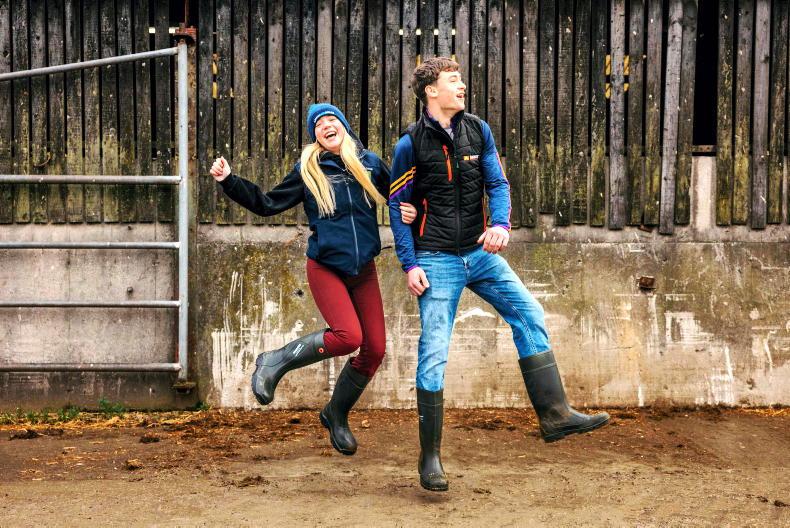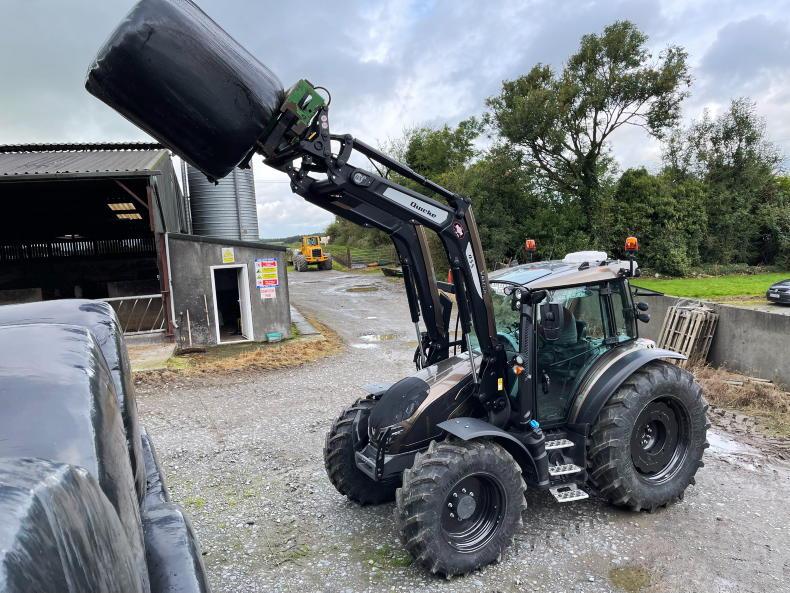Over the years, agricultural tractors have been adapted to cater for an enormous variety of applications. Such is the versatility of the tractor, many are found far beyond their intended agricultural purpose.
One organisation that utilises a wide variety of tractors to help launch rescue boats around the coasts of Ireland and the UK is the Royal National Lifeboat Institution (RNLI).
Tractors, crawler and wheeled, provide the perfect solution to launching rescue vessels into the sea along an extremely varied coastline.
Quite incredibly, the RNLI recently commemorated 100 years of tractor-launched lifeboats.
Founded in 1824, the RNLI currently operates 46 stations around the Irish coastline, as well as major inland waterways.
The types of boats provided at each station and the launching methods (not just tractors) vary depending on local needs.
Incidentally, the first RNLI lifeboat station in Ireland was established in Arklow, Co Wicklow, in 1826.

Tractors such as nthis New Holland T5040 make up a large part of the conventional tractor fleet.
Tractors
The RNLI utilises a huge variety of specialised, adapted and conventional (including compact) tractors in its fleet.
Boat size, launching conditions and terrain dictate what type of tractor is used for launching a lifeboat. It’s worth noting that other launching methods are used too, such as slipways and winches.
Vehicles such as Land Rover Defenders and ATVs are also used where the need or conditions dictate.
Conventional tractors, including compact tractors, are largely sourced from New Holland.
The New Holland 85hp T5040 would generally be the largest of its conventional tractors. The Shibaru-built 24hp New Holland TC24D would be typical of the compact tractors the RNLI uses. It has quite a number of the newer LS-built Boomer models also.
Compact tractors are generally used for launching smaller craft. For example, Wexford, Courtown and Wicklow RNLI stations use New Holland TC24D compact tractors to launch RNLI’s D-class inshore lifeboats.
Helvic Head RNLI in the Waterford Gaeltacht uses a New Holland T5040 to launch its Atlantic 85 inshore lifeboat.
Further down the coast, Youghal RNLI station uses a County-based Talus MB-764 built by Clayton Engineering to launch its Atlantic 85 inshore lifeboat.
Bundoran RNLI station, Co Donegal, uses a tractor designed and built Clayton Engineering Ltd for the RNLI. This articulated and spectacular-looking tractor is the Talus MB-4H ‘Bendy’, which is also used to launch an Atlantic 85 inshore lifeboat.
Clogherhead RNLI station has an even more spectacular launching tractor for its Shannon-class lifeboat. The SLARS (Shannon Launch and Recovery System) acts as a mobile slipway for the lifeboat and has a unique turntable cradle, which can rotate the lifeboat 180º, ready to be launched again within 10 minutes.
Tramore lifeboat station uses a small skid-steer crawler tractor, the Tooltrak, to launch its D-class inshore lifeboat. The Tooltrak is built by Loglogic in the UK and adapted for use in the RNLI.
There are many, many more examples of tractors or tractor-derived machines for launching lifeboats around the coasts of Ireland and Great Britain.

Bridlington (UK) lifeboat launch. \ RNLI
Manufacturer
It may surprise some, but the RNLI is a tractor manufacturer, albeit a very specialised tractor manufacturer.
In January 2019, the RNLI acquired Welsh company Clayton Engineering Ltd, with which it has had a very close working relationship for many years.
The acquisition followed the retirement of Clayton’s owners and managing director.
The firm manufactures and supplies almost half of the RNLI’s lifeboat launch and recovery systems used throughout Ireland and the UK.
History
This year, on World Heritage Day (18 April), the RNLI looked back at the first tractors used to launch lifeboats a century ago and how their technology has advanced to help save lives at sea.
RNLI lifeboats often take centre stage in rescues. However, many can’t launch without a tractor and the dedicated shore crew.
Operators often launch the lifeboat in raging seas and darkness, and a safe, quick launch can make the difference between life and death. The lifeboat and crew might get the public’s attention, but the tractor and the shore crew are the unsung heroes who more than pull their weight – literally.
This year marks 100 years since the RNLI introduced tractors to launch its lifeboats and the technology nowadays – with the latest Shannon Launch and Recovery System (SLARS) – is unrecognisable to all those years ago. Prior to the 1920s, it wasn’t unusual to see horses being used to pull lifeboats through communities to reach a point where they could safely be launched.
In 1920, Captain Howard FJ Rowley, RNLI chief inspector of lifeboats, said: “If we can find a mechanical means for launching, we shall greatly increase the efficiency, certainty and speed of the service.”
That year, a 35hp Clayton Caterpillar Tractor was trialled at Hunstanton Beach, in Norfolk, England, over flat sands, sand dunes and rocky ground.
Despite the tractor once becoming submerged, the launch was successful using only crew and four helpers, where under ordinary conditions such a launch would require eight or 10 horses and as many helpers.
A year later, the RNLI had purchased 20 Clayton Caterpillar tractors, adapted and distributed them to stations. By 1928, the four-wheel-drive tractor with a 60hp petrol engine, which could cope with steep shingle beaches, was also in service.
Working jointly with engineering companies to adapt agricultural tractors, over the years the RNLI introduced new, more powerful and waterproof tractors to launch lifeboats as quickly and safely as possible.
Though some lifeboats are kept afloat at a station, others are in boathouses and need transporting across beaches and down slipways before entering the sea.

The SLARS-Shannon Launch and Recovery System. Photo credit; RNLI/Pat Browne.
Demands
By the late 1940s, 16 Case L tractors had been built and in the 1950s the Challenger III diesel crawler tractor was constructed, powerful enough to meet the demands of launching the heavy 11m Oakley class lifeboat. The 1960s and 1970s saw more Case tractor models, including the Case 1150 tractor with a watertight cab and some with a bulldozer blade to flatten beaches.
In the 1970s, the first of the Talus tractors were brought in to launch inshore lifeboats. Then in the 1980s, earlier tractors began to be replaced by the Talus MB-H, a vehicle designed jointly with Mike Bigland (Preparations) Ltd. It was the first vehicle to be purpose-designed for launching lifeboats, rather than being an adaptation of an existing tractor design.
In 1990, the Talus MB-4H, powered by a 105hp turbo diesel engine was developed. Known as the ‘Bendy’, it launches B-class inshore lifeboats.
There’s also the Talus MB-764, which is based on a Ford County tractor with a watertight shell, which launches both B-class and D-class lifeboats. Softrak and Tooltrak vehicles and the Haegglund BV also launch inshore lifeboats.
Mentioned earlier, the rubber-tracked SLARS is among the latest innovations being used by the RNLI.
RNLI machinery trainer Mark Perry said: “The RNLI have progressed not only the development of lifeboats over the years, but also the launch and recovery systems associated with the new boats.
“Volunteers training on the new equipment will spend in the region of 40 hours conducting basic training and learning the full extent of all its capabilities – it’s certainly come a long way since the first tractor was introduced 100 years ago.”
About the RNLI
The RNLI charity saves lives at sea. Its volunteers provide a 24-hour search and rescue service around the United Kingdom and Republic of Ireland coasts. The RNLI operates over 238 lifeboat stations in the UK and Ireland and, in a normal year, more than 240 lifeguard units on beaches around the UK and Channel Islands. The RNLI is independent of Coastguard and government and depends on voluntary donations and legacies to maintain its rescue service. Since the RNLI was founded in 1824, its lifeboat crews and lifeguards have saved over 142,700 lives.
Over the years, agricultural tractors have been adapted to cater for an enormous variety of applications. Such is the versatility of the tractor, many are found far beyond their intended agricultural purpose.
One organisation that utilises a wide variety of tractors to help launch rescue boats around the coasts of Ireland and the UK is the Royal National Lifeboat Institution (RNLI).
Tractors, crawler and wheeled, provide the perfect solution to launching rescue vessels into the sea along an extremely varied coastline.
Quite incredibly, the RNLI recently commemorated 100 years of tractor-launched lifeboats.
Founded in 1824, the RNLI currently operates 46 stations around the Irish coastline, as well as major inland waterways.
The types of boats provided at each station and the launching methods (not just tractors) vary depending on local needs.
Incidentally, the first RNLI lifeboat station in Ireland was established in Arklow, Co Wicklow, in 1826.

Tractors such as nthis New Holland T5040 make up a large part of the conventional tractor fleet.
Tractors
The RNLI utilises a huge variety of specialised, adapted and conventional (including compact) tractors in its fleet.
Boat size, launching conditions and terrain dictate what type of tractor is used for launching a lifeboat. It’s worth noting that other launching methods are used too, such as slipways and winches.
Vehicles such as Land Rover Defenders and ATVs are also used where the need or conditions dictate.
Conventional tractors, including compact tractors, are largely sourced from New Holland.
The New Holland 85hp T5040 would generally be the largest of its conventional tractors. The Shibaru-built 24hp New Holland TC24D would be typical of the compact tractors the RNLI uses. It has quite a number of the newer LS-built Boomer models also.
Compact tractors are generally used for launching smaller craft. For example, Wexford, Courtown and Wicklow RNLI stations use New Holland TC24D compact tractors to launch RNLI’s D-class inshore lifeboats.
Helvic Head RNLI in the Waterford Gaeltacht uses a New Holland T5040 to launch its Atlantic 85 inshore lifeboat.
Further down the coast, Youghal RNLI station uses a County-based Talus MB-764 built by Clayton Engineering to launch its Atlantic 85 inshore lifeboat.
Bundoran RNLI station, Co Donegal, uses a tractor designed and built Clayton Engineering Ltd for the RNLI. This articulated and spectacular-looking tractor is the Talus MB-4H ‘Bendy’, which is also used to launch an Atlantic 85 inshore lifeboat.
Clogherhead RNLI station has an even more spectacular launching tractor for its Shannon-class lifeboat. The SLARS (Shannon Launch and Recovery System) acts as a mobile slipway for the lifeboat and has a unique turntable cradle, which can rotate the lifeboat 180º, ready to be launched again within 10 minutes.
Tramore lifeboat station uses a small skid-steer crawler tractor, the Tooltrak, to launch its D-class inshore lifeboat. The Tooltrak is built by Loglogic in the UK and adapted for use in the RNLI.
There are many, many more examples of tractors or tractor-derived machines for launching lifeboats around the coasts of Ireland and Great Britain.

Bridlington (UK) lifeboat launch. \ RNLI
Manufacturer
It may surprise some, but the RNLI is a tractor manufacturer, albeit a very specialised tractor manufacturer.
In January 2019, the RNLI acquired Welsh company Clayton Engineering Ltd, with which it has had a very close working relationship for many years.
The acquisition followed the retirement of Clayton’s owners and managing director.
The firm manufactures and supplies almost half of the RNLI’s lifeboat launch and recovery systems used throughout Ireland and the UK.
History
This year, on World Heritage Day (18 April), the RNLI looked back at the first tractors used to launch lifeboats a century ago and how their technology has advanced to help save lives at sea.
RNLI lifeboats often take centre stage in rescues. However, many can’t launch without a tractor and the dedicated shore crew.
Operators often launch the lifeboat in raging seas and darkness, and a safe, quick launch can make the difference between life and death. The lifeboat and crew might get the public’s attention, but the tractor and the shore crew are the unsung heroes who more than pull their weight – literally.
This year marks 100 years since the RNLI introduced tractors to launch its lifeboats and the technology nowadays – with the latest Shannon Launch and Recovery System (SLARS) – is unrecognisable to all those years ago. Prior to the 1920s, it wasn’t unusual to see horses being used to pull lifeboats through communities to reach a point where they could safely be launched.
In 1920, Captain Howard FJ Rowley, RNLI chief inspector of lifeboats, said: “If we can find a mechanical means for launching, we shall greatly increase the efficiency, certainty and speed of the service.”
That year, a 35hp Clayton Caterpillar Tractor was trialled at Hunstanton Beach, in Norfolk, England, over flat sands, sand dunes and rocky ground.
Despite the tractor once becoming submerged, the launch was successful using only crew and four helpers, where under ordinary conditions such a launch would require eight or 10 horses and as many helpers.
A year later, the RNLI had purchased 20 Clayton Caterpillar tractors, adapted and distributed them to stations. By 1928, the four-wheel-drive tractor with a 60hp petrol engine, which could cope with steep shingle beaches, was also in service.
Working jointly with engineering companies to adapt agricultural tractors, over the years the RNLI introduced new, more powerful and waterproof tractors to launch lifeboats as quickly and safely as possible.
Though some lifeboats are kept afloat at a station, others are in boathouses and need transporting across beaches and down slipways before entering the sea.

The SLARS-Shannon Launch and Recovery System. Photo credit; RNLI/Pat Browne.
Demands
By the late 1940s, 16 Case L tractors had been built and in the 1950s the Challenger III diesel crawler tractor was constructed, powerful enough to meet the demands of launching the heavy 11m Oakley class lifeboat. The 1960s and 1970s saw more Case tractor models, including the Case 1150 tractor with a watertight cab and some with a bulldozer blade to flatten beaches.
In the 1970s, the first of the Talus tractors were brought in to launch inshore lifeboats. Then in the 1980s, earlier tractors began to be replaced by the Talus MB-H, a vehicle designed jointly with Mike Bigland (Preparations) Ltd. It was the first vehicle to be purpose-designed for launching lifeboats, rather than being an adaptation of an existing tractor design.
In 1990, the Talus MB-4H, powered by a 105hp turbo diesel engine was developed. Known as the ‘Bendy’, it launches B-class inshore lifeboats.
There’s also the Talus MB-764, which is based on a Ford County tractor with a watertight shell, which launches both B-class and D-class lifeboats. Softrak and Tooltrak vehicles and the Haegglund BV also launch inshore lifeboats.
Mentioned earlier, the rubber-tracked SLARS is among the latest innovations being used by the RNLI.
RNLI machinery trainer Mark Perry said: “The RNLI have progressed not only the development of lifeboats over the years, but also the launch and recovery systems associated with the new boats.
“Volunteers training on the new equipment will spend in the region of 40 hours conducting basic training and learning the full extent of all its capabilities – it’s certainly come a long way since the first tractor was introduced 100 years ago.”
About the RNLI
The RNLI charity saves lives at sea. Its volunteers provide a 24-hour search and rescue service around the United Kingdom and Republic of Ireland coasts. The RNLI operates over 238 lifeboat stations in the UK and Ireland and, in a normal year, more than 240 lifeguard units on beaches around the UK and Channel Islands. The RNLI is independent of Coastguard and government and depends on voluntary donations and legacies to maintain its rescue service. Since the RNLI was founded in 1824, its lifeboat crews and lifeguards have saved over 142,700 lives.













SHARING OPTIONS